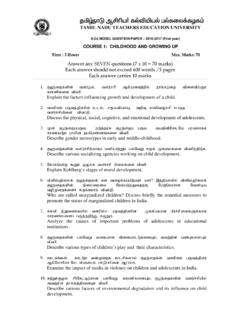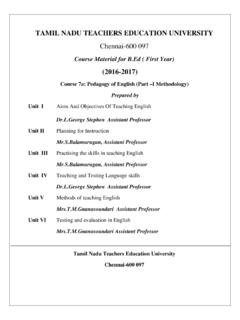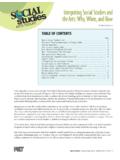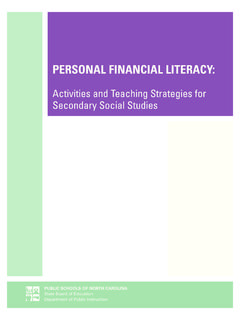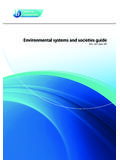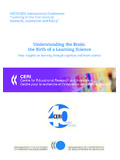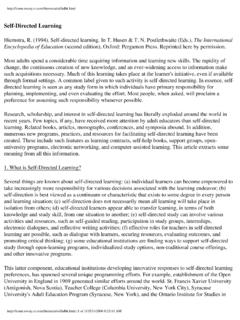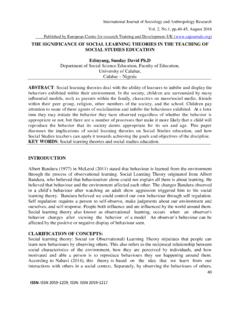Transcription of jkpo;ehL Mrphpah; fy;tpapay; gy;fiyf;fofk;jkpo;ehL …
1 jkpo ;ehL mrphpah ; fy; tpapay ; gy; fiyf ;fofk; jkpo ;ehL mrphpah ; fy; tpapay ; gy; fiyf ;fofk; jkpo ;ehL mrphpah ; fy; tpapay ; gy; fiyf ;fofk; jkpo ;ehL mrphpah ; fy; tpapay ; gy; fiyf ;fofk; TAMIL NADU TEACHERS EDUCATION UNIVERSITY Chennai - 600 097. Course Material for (First Year) ( 2016-2017 ) Course: 3 learning and teaching Prepared by Unit VI learning Centered teaching , Professor and Head , Associate Professor Unit VII teaching in Diverse Classroom Stephen, Assistant Professor Unit VIII learning in and out of School , Assistant Professor Unit IX Teacher Student Relationship Unit X teaching as a Profession &.
2 Assistant Professor Department of Pedagogical Sciences Tamil Nadu Teachers Education University Chennai- 600 097 Tamil Nadu Teachers Education University 2 TAMIL NADU TEACHERS EDUCATION UNIVERSITY Chennai - 600 097 Unit-VI: LEARNER-CENTERED teaching Objectives: 1. Know the meaning and characteristics of learner-centered teaching . 2. Describe the Need for learner-centered approaches. 3. Explain teacher-centered learning . 4. Comprehend learners central techniques of teaching .
3 Introduction: Student-centered learning , also known as learner-centered education, broadly encompasses methods of teaching that shift the focus of instruction from the teacher to the student. In original usage, student-centered learning aims to develop learner autonomy and independence by putting responsibility for the learning path in the hands of students. Student-centered instruction focuses on skills and practices that enable lifelong learning and independent problem-solving. Student-centered learning theory and practice are based on the constructivist learning theory that emphasizes the learner's critical role in constructing meaning from new information and prior experience.
4 Student-centered learning puts students' interests first, acknowledging student voice as central to the learning experience. In a student-centered learning space, students choose what they will learn, how they will learn, and how they will assess their own learning . This is in contrast to traditional education, also dubbed "teacher-centered learning ", which situates the teacher as the primarily "active" role while students take a more "passive", and receptive role. In a teacher-centered classroom, teachers choose what the students will learn, how the students will learn, and how the students will be assessed on their learning .
5 On the Contrary, student-centered learning requires students to be active, responsible participants in their own learning and with their own pace of learning . Tamil Nadu Teachers Education University 3 Usage of the term "student-centered learning " may also simply refer to educational mindsets or instructional methods that recognize individual differences in learners. In this sense, student-centered learning emphasizes each student's interests, abilities, and learning styles, placing the teacher as a facilitator of learning for individuals rather than for the class as a whole.
6 Meaning: Learner-centered teaching is an approach to teaching that is increasingly being encouraged in higher education. Learner-centered teachings do not employ a single teaching method. This approach emphasizes a variety of different types of methods that shift the role of the instructors from givers of information to facilitating student learning . Traditionally, instructors focused on what they did, and not on what the students learnt Educators call this traditional method, instructor-centered teaching . In contrast, learner-centered teaching occurs when instructors focus on student learning .
7 Learner-Centered teaching /Learner -Centered learning Educators commonly use three phrases with this approach. Learner- centered teaching places the emphasis on the person who is doing the learning (Weimer, 2002). learning -centered teaching focuses on the process of learning . Both phrases appeal to faculty because these phrases identify their critical role of teaching in the learning process. The phrase student centered learning is also used, but some instructors do not like it because it appears to have a consumer focus, seems to encourage students to be more empowered, and appears to take the teacher out of the critical role.
8 Five Characteristics of Learner Centered teaching Active learning , student engagement and other strategies that involve students and mention learning are called learner-centered. And although learner-centered teaching and efforts to involve students have a kind of bread and butter relationship, they are not the same thing. In the interest of more definitional precision, I d like to propose five characteristics of teaching that make it learner-centered. Tamil Nadu Teachers Education University 4 1.
9 Learner-centered teaching engages students in the hard, messy work of learning . Teachers are doing too many learning tasks for students. We ask the questions, we call on students, and we add detail to their answers. We offer the examples. We organize the content. We do the preview and the review. On any given day, in most classes teachers are working much harder than students. I m not suggesting we never do these tasks, but I don t think students develop sophisticated learning skills without the chance to practice and in most classrooms the teacher gets far more practice than the students.
10 2. Learner-centered teaching includes explicit skill instruction. Learner-centered teachers teach students how to think, solve problems, evaluate evidence, analyze arguments, generate hypotheses all those learning skills essential to mastering material in the discipline. They do not assume that students pick up these skills on their own, automatically. A few students do, but they tend to be the students most like us and most students aren t that way. Research consistently confirms that learning skills develop faster if they are taught explicitly along with the content.



